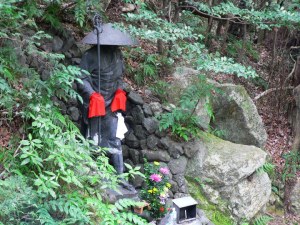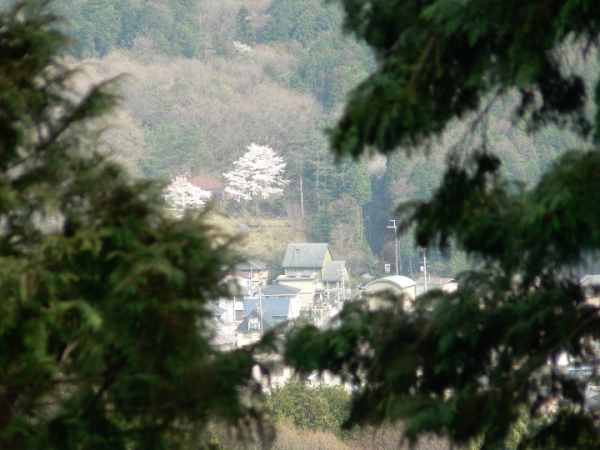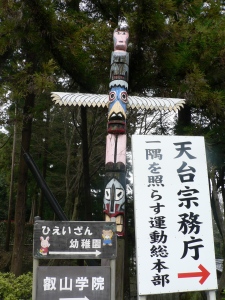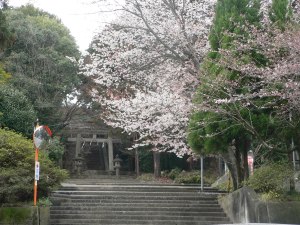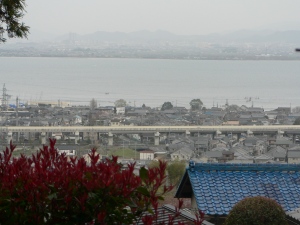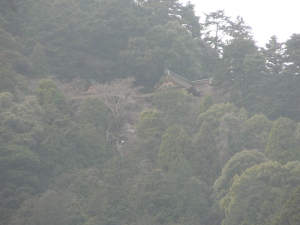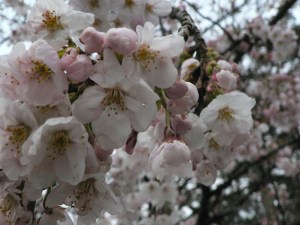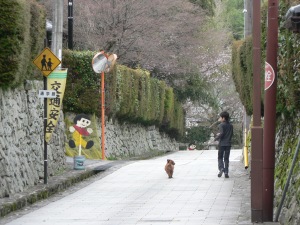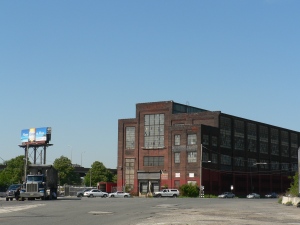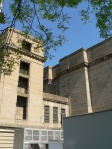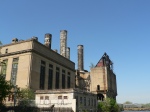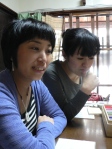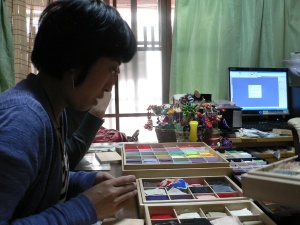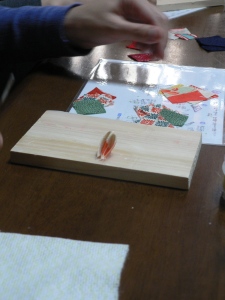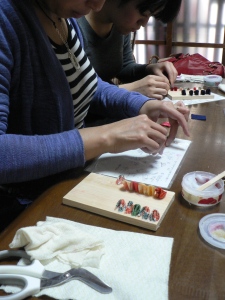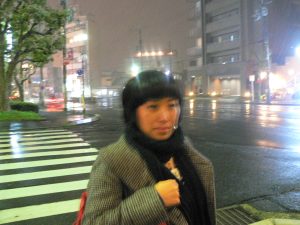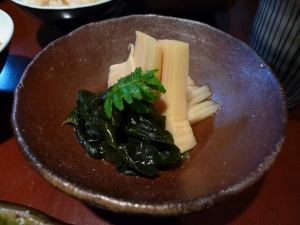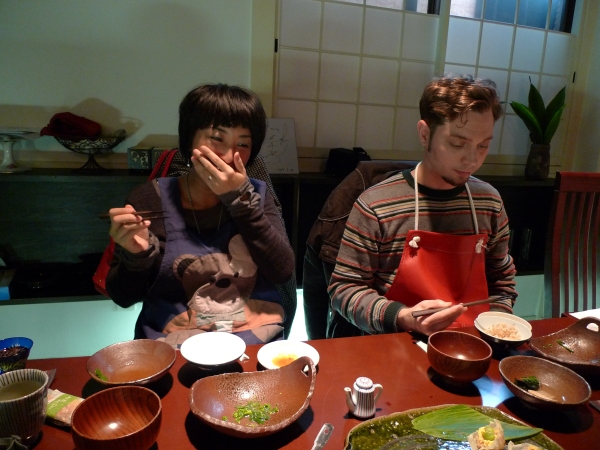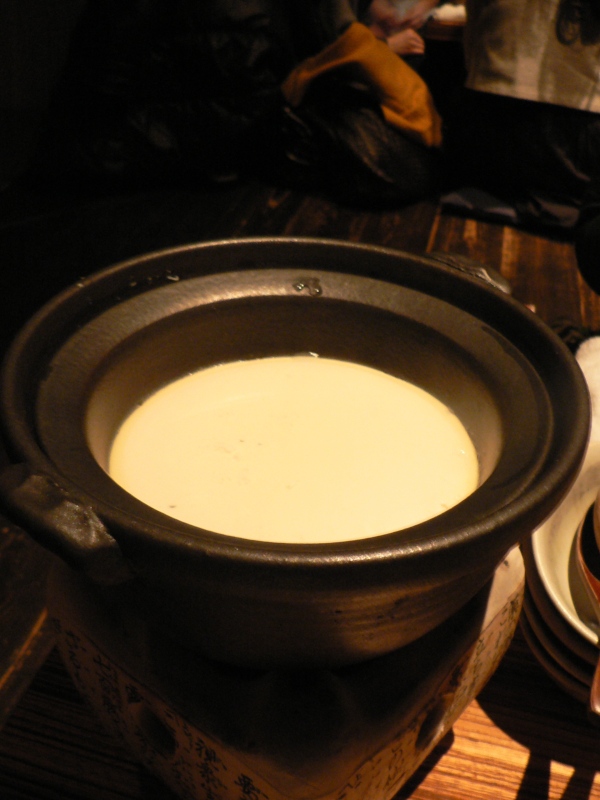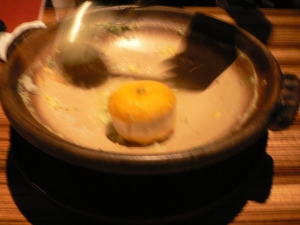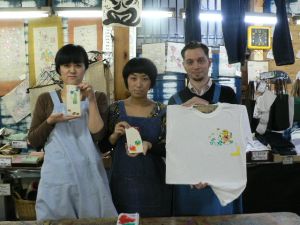Coming out the other side
 This is the gate to the Kiyomizu temple in Kyoto one of the final 21 sites to be considered for the “New 7 wonders of the World”. This is a very popular tourist area and one of the places that is known for its cherry and maple trees. Beyond the gate here are another set of stairs, a purification fountain and a place to purchase tickets to enter into the womb of Daizuigu Bosatsu. So… how many of you out there can say that you’ve been in a Bodhisattva’s hoo-hoo? We bought our tickets to ride and entered in a single file line down a set of stairs into pitch black. A guide line on the left side of the wall helped to navigate the darkness. Jostling each other and strangers taking 90 degree turns in complete darkness we made friends with some people we’ve never seen. For 5 minutes we wound around listening for each others breath and voices with a tentative hand out in front. A splash of light entered into my vision and there is this stone being illuminated from above- very Indiana Jones is the easiest way to describe it. Turning the the stone clockwise you make a wish. Back into darkness you leave the stone and finally more light breaks down a stairway next to where you entered. I was reborn and friends and family popped out all around me. I don’t know if the looks in our eyes were just a readjustment to the sun or what.
This is the gate to the Kiyomizu temple in Kyoto one of the final 21 sites to be considered for the “New 7 wonders of the World”. This is a very popular tourist area and one of the places that is known for its cherry and maple trees. Beyond the gate here are another set of stairs, a purification fountain and a place to purchase tickets to enter into the womb of Daizuigu Bosatsu. So… how many of you out there can say that you’ve been in a Bodhisattva’s hoo-hoo? We bought our tickets to ride and entered in a single file line down a set of stairs into pitch black. A guide line on the left side of the wall helped to navigate the darkness. Jostling each other and strangers taking 90 degree turns in complete darkness we made friends with some people we’ve never seen. For 5 minutes we wound around listening for each others breath and voices with a tentative hand out in front. A splash of light entered into my vision and there is this stone being illuminated from above- very Indiana Jones is the easiest way to describe it. Turning the the stone clockwise you make a wish. Back into darkness you leave the stone and finally more light breaks down a stairway next to where you entered. I was reborn and friends and family popped out all around me. I don’t know if the looks in our eyes were just a readjustment to the sun or what.
This is the main outlook with a view of Kyoto’s valley. According to the temples website, “The expression “to jump off the porch at Kiyomizu” is the Japanese equivalent of the English expression “to take the plunge.” This refers to an Edo period tradition that held that, if one were to survive jumping from the terrace, one’s wish would be granted. 234 jumps were recorded in the Edo period and of those, 85.4% survived.” Thats a good percentage for wishes right? I’m thinking optimistic on what they wished for here. Oh yeah, the terrace is 13 meters tall, thats a little over 42 and 1/2 feet.
Right before we reached the terrace we came across people handing out tea. TEA IS EVERYWHERE. Why were they handing out tea? Well it was Kannon’s birthday! Kannon the Buddhist representation of compassion and mercy’s birthday and we were being served tea! Thanks buddy! Oh wait Kannon has eleven faces and can take the form of male or female… Thanks friend-o! This is his/her picture here.
So there are eleven faces, eleven aspects.. but which one is this? The same one they all are of course. This is the main figure at the temple. Now further avoiding why the temple’s name translates into “pure water” I’ll change the subject. One of the things people ask me is, “Have you seen a Geisha?” Once. We were in the Maiko district at dusk and this taxi cab pulls up to the curb and its back door springs open almost immediately I hear a volume increase in people’s voices behind me, I turn to look and a blur of color speeds past Motoko and I into the readied taxi. The taxi: surrounded by photographers/ Geisha eludes a frontal portrait. The door shuts – the taxi gone. Cut and print. I did take a nice picture of a what I will call a Fakeisha. Girls, especially Asian tourists like to dress up as Geisha and go out into the city and have their pictures taken. When in Rome… and all that. I mean think about it… would you go to work if nobody was paying you? And to be clear they are not prostitutes. It is more of a strict escort/entertainment service. Honestly though, nobody has asked me that.
Now further avoiding why the temple’s name translates into “pure water” I’ll change the subject. One of the things people ask me is, “Have you seen a Geisha?” Once. We were in the Maiko district at dusk and this taxi cab pulls up to the curb and its back door springs open almost immediately I hear a volume increase in people’s voices behind me, I turn to look and a blur of color speeds past Motoko and I into the readied taxi. The taxi: surrounded by photographers/ Geisha eludes a frontal portrait. The door shuts – the taxi gone. Cut and print. I did take a nice picture of a what I will call a Fakeisha. Girls, especially Asian tourists like to dress up as Geisha and go out into the city and have their pictures taken. When in Rome… and all that. I mean think about it… would you go to work if nobody was paying you? And to be clear they are not prostitutes. It is more of a strict escort/entertainment service. Honestly though, nobody has asked me that.
After the temple we ambled down the shops lost each other, reconnected, finally found some food, and past by Hokan-ji Temple, known colloquially as Yasaka-no-to (Yasaka Pagoda). Inspired by a dream the 46 meter tall pagoda was originally built in 589 by Prince Shotoku.
I might post a more imposing picture of it later but I like the juxtaposition of this one. For an aerial view visit http://wikimapia.org/#lat=34.9984795&lon=135.7788759&z=19&l=0&m=s&v=9
Later Gators.
To see what was on the other side…
It’s amazing how quickly later turns into now. Back from Japan for over a month now and I still haven’t posted pictures from the best parts. Early April brought visits from my Mother, my Aunts Donna and Maredith, along with our good friends Art and Margo. I think everybody had a good time as possible with us rushing them around for a week trying to get them everywhere but Bedlam. I was excited to have them in town and present for Motoko’s and my second wedding. (Don’t ask what we are going to do for our second anniversary, that’s just too much pressure right now.) The ceremony was on the 9th and following that was the Sanno-sai festival. Oh so many pictures and words so little time. I’m impatient and want to get these photos posted so I can start in on Whats Happening Now and praise Ralph. So lets get past these pop culture reference jokes that are too esoteric and hop into it. The day before my mom and aunts arrived into town I traveled with Motoko, my sister-in-law, and mother-in-law to a temple a stones through away from where (supposedly the first novel ever) The Tale of Genji was written. The temple is on the side of a winding river/mountain road and we had to climb 700 steps to get to the top. We alternated running and walking up and by the time we reached the bottom again our legs were shaking. Just in time to prepare us for touring around the next week. The temple is along the Setagawa River, Tachiki Kannon (Tachiki-san Anyo-ji Temple) is widely worshipped as a protector from evil. According to legend, Kobo Daishi (posthumously called Kukai), built this temple in the early Heian period at the “critical age” of 42. His statue was at the base of the stairs.
Looking back on this, (and double checking my facts before I post things) it was an interesting choice for Motoko’s mom to take us here. Kūkai made a trip to China in his twenties and had expected to spend 20 years studying there, but within a few short months he was to receive the final initiation, and become a master of the esoteric lineage. When he returned from China Emperor Heizei exhibited no great enthusiasm for Buddhism and Kukai was eclipsed by Saichō, the founder of the Tendai school. Saichō requested, in 812, that Kūkai give him the introductory initiation, which Kūkai agreed to do. He also granted a second-level initiation upon Saichō, but refused to bestow the final initiation (which would have qualified Saichō as a master of esoteric Buddhism) because Saichō had not completed the required studies, leading to a falling out between the two that was not resolved. Just a note before I rearrange more sentences from wikipedia: Tendai Buddhism was formed in Motoko’s neighborhood. Emperor Heizei became ill in 809 and retired the throne to Emperor Saga (who was supposed to be the first Japanese Emperor to drink tea). Shortly after taking the throne Saga became ill and Heizei formed a rebellion, which had to be put down by force. Kūkai petitioned the Emperor to allow him to carry out certain esoteric rituals which were said to “enable a king to vanquish the seven calamities, to maintain the four seasons in harmony, to protect the nation and family, and to give comfort to himself and others”. The petition was granted and Kukai became one of the most influential monks in his lifetime. Motoko’s mother went to college to learn the art of tea ceremony. To me this was all saying, “Yes, our neighborhood is interesting and there is a lot of history in it but it spreads out to bigger things. How are things connected? There is always something larger. Find more patterns.” Eh, and maybe she just wanted us to get some exercise with those steps. Somewhere close to the top (I wasn’t patient enough to continue counting the stairs after 213) I found a break in the trees.
As we approached the top I could smell incense wafting down the zig-zagging stairs. I raced my sister-in-law up the last couple of flights and bounded to the top surprising a man who looked like he was straight out of a 1980’s Yakuza film. He sported a stone-cold Elvis pompadour, an acid-washed blue-jean jogging suit (you read correctly) unzipped at the top with a gold medallion. It looked like he had just reached the top as well as he was a little sweaty and had just lit a cigarette. The three of us exchanged looks. My sister-in-law and I and then him at the two of us looking back at him. We paused a little too long and he puffed his cigarette. Motoko and her mom came up behind us and we headed towards a fountain to cleanse ourselves by washing our hands. The visitors part of the complex was smaller than most I had been to but the walk/run up the stairs made things seem large. There is a small banzai garden to the right along with a station that provides visitors with an extremely tasty lemon-grass tea. There is another statue at the top that I believe is Kukai ridding a deer. If i remember correctly folk-lore has it that when the level of the Seta river was very high, a white deer appeared and carried Kukai on its back across the river. After that, he found the tree which was special in the forest on Tachiki-mountain, and then he carved two “Kannon” out of the living tree. One version of the story relates that one carving stayed at the mountain and the other one he threw into the sea for good luck. 16 years later it washed back on shore and people enshrined it in that town. I don’t remember the town name. Upon doing more research I found out that many people visit “Tachiki-san” in order to pray for family safety, health, and good luck . Tachiki Kannon is the representation of mercy.
There was a small prayer area to the Konnan along with a pathway that went around the backside of the temple and passed by a large bell that was maybe 4 feet in diameter. You could see other paths leading off into the woods but they were gated off and at the apex you could just see the top of the mountain ridge. I had to resist jumping over the boundary to just look on the other side as Motoko and the family frowned on it. I wonder if Japanese people see this crook in the path and think about the 700 steps they climbed wondering, “All these steps and here I am on this temple path that is another 30-40 steps above the complex and there is the top of the mountain. I’m not supposed to cross this 3 foot tall ramshackle barrier but a view of the other side of the mountain is right there.” Or do most not even think twice about it because they are culturally wired not to. It doesn’t matter what was on the other side now, because that wasn’t part of that journey. The picture below is of a smaller bohdavista and not the Tachiki Kannon. You’ll have to visit to see the bohdavista, and look elsewhere for more information. This rabbit hole has been dug look for separate passageways elsewhere. No wait stay. I’ll post some more tomorrow. More pictures less writing maybe..
This is historic! That is historic? pt 2
Exploring our own backyards can be exciting and at times feel like micro managed observation, or like an O.C.D. archeological dig in your house’s crawl space. Or maybe I’m just desperate to connect with something in Philly. While we were in Japan I got to explore Motoko’s neighborhood and while I’m sure she found my exclamations of interest amusing. The impact of growing up around your own history with well taken care of national treasures has definately had an impact on what I can divine of Motoko’s thought structure. I would never discount her parent’s influence but her childhood environment is impressive. Motoko grew up at the base of Mt. Hiei, which is the birthplace of Tendai Budhism and also considered the home of the Shinto gods and demons as well as Kaihogyo. Kaihogyo are monks who can, and do, run between 30 to 84 kilometers A DAY. Wikipedia that one. There is also Hiyoshi Taisha shrine which is reportedly the progenator shrine of Shintoism. Motoko and I held our second marriage there as well, the first being at Philadelphia’s City Hall… which isn’t quite as old at barely 109 years. Hiyoshi Taisha has been around since at least the 8th century. Philadelphia’s city hall was once the “tallest habitable” building and is the 2nd tallest masonry building, hence its 20 foot thick base walls. Back to Japan now…
This was one of the first interesting things I saw walking around Motoko’s neighborhood. I think the totem pole was made by the local girl scout troupe. I know a lot of Japanese people think most things American are cool and fashionable, and its reciprocated at home in the U.S. but I found this interesting on a different level as well. The Toba Catastrophe supposedly brought the human population down to 1,000-10,000 breeding pairs about 70,000 years ago. According to the book First Americans, geneticists have established that the peoples of Asia and the Americas were from the same population group 20,000-40,000 years ago. That is a big circle. Further still, for me to have European ancestors with, a very small fraction (1/64th), that of Native American… our relationship isn’t East meets West but East meets East meets West. Finally after all of these thousands of years we are back together again.
Earlier this winter, back in Philly, Motoko and I had the pleasure of over 80 inches of snowfall over the course of a couple of months. We were ready for the warmer weather and the early springtime buds and blooms began to show themselves. Springtime in Japan = cherry and plum blossoms, so here you go!
All of the early bloomers were white or light pink and reminded me of the dogwood trees along Prince Avenue in Athens, Georgia. While the main area of the Hiyoshi complex was about a 5 minute walk from Motoko’s house… on the street behind the house was the neighborhood shrine that is one of the community meeting places for the neighborhood. I imagine just having a place like this encourages community functions. Would you not want to hang out at a fire pit there and grill out hotdogs and talk shop about how to make your neighborhood better?
Returning back to Philly and its littered streets, the disparity of its income gap, its non-appreciation of what it has started to get to me. Philly has some great potential, it’s still listed as 9th on the worlds to cities for GDP, 5th in the U.S. To give some perspective Tokyo is rated #1 and New York #2. Philly has some of the biggest beautiful stains of history concerning the U.S. and the homes are some of the best preserved with their stone foundations. I began to wonder if we should just pack up and move to some place that knew what it had instead of being in an exploited city. But I’m going to run into that everywhere here, be it NY, Chicago, San Fransisco, or Atlanta. They all have their issues of carpet-baggers, negligent mega corporations, ocean oil slicks, education, etc. I think it can boil down to our sense of self-worth in the reflection of how we treat our home. I see a lot of territorial pissing going on in claiming our neighborhoods instead of a community helping each other out. I think two of the great American exclamations are, “Stay out of my business and I’ll stay out of yours.” and “Procrastinate now!” We don’t have a high tolerance of allowing someone to help us, it feels like interventions. Maybe because we wait until it has come to the point of intervention. So to get to the short of it, we are going to stick it out and start helping our neighborhood by volunteering for clean up duty. We’ve got to start some where. We plan on hugging trees next Saturday.
O.K., so back to Japan… and my envy of her parents neighborhood. All around were these walls, some as tall as 20 feet, that were made of hand laid stones with out the use of mortar. Moss growing along the sides of many of them. I still can’t get over the size of the streets in her neighborhood! My mom and aunts tell me it reminds them of small European town streets. The picture below sports a two-way street. On the left hand side you can see a channel for the mountain run off to reach the lake. Just about every street had this and the amount of water from mountain run off surrounding you is amazing. Makes for some humid Summers though.
I’ll post some new paintings soon and go into a little bit about where Motoko and I get a few ideas from… and I just found my Harbrace.
Big Wheels Keep on Roll’n
We’ve had some busy days and busy nights since we’ve been back. Typical days for us now are: out of bed by 7:30 am (sometimes I’m a little behind on this one), coffee and breakfast, check the emails, and start in on the studios by 9 am. I’ll usually try to get two small Etsy paintings finished by lunch and after lunch I’m working on some oil paintings. Motoko’s been putting together some nice pieces of jewelery she is making from reclaimed kimonos and Japanese fabrics, as well as some cool t-shirts. After dinner, if I’ve been on a roll, its back to the studio or if I need a break we’ll watch a movie while working on either posting things online or making hand-made books. Lost is a rerun tonight so things don’t require my attention and I can work on things with more parts of my brain in tact. Then it is: try to be in bed by midnight.
Today I sent off a packet for entry into a juried show at a local gallery that’s been written up in the NY Times before. I just found out about it last night and the deadline is the 30th. Cross my fingers on that one or its $25.00 wasted. Well at least I get to go through some photos from Japan and not think about juries.
Hey what the heck is <—– that? That is the shop Motoko and Reiko learned how to make Tsumamizaiku. I can hear you already. Tsumamizaiku are traditional Japanese decorative fabric hairpins for women and girls. Did that sentence have enough adjectives? It was a cold day out but it was in a part of Kyoto I hadn’t been to yet so I thought I’d brave the weather forecast and tag along. We took the local train and met up with Reiko and hopped a bus over to that side of town, which I’m told is around the Silver Pavilion site. This was late March and we had packed preparing for spring weather. We did have some jackets but they weren’t quite up to the job. Well that day it decided it was going to yuki all over the place. Snow that is… and man did the wind kick up. We started hunting for this shop and the day started getting windier and colder. So try to picture us racing around this unfamiliar neighborhood, the snow jettisoning down from the clouds trying dangerous aerial maneuvers, that would make Maverick drop out of top gun, in attempts to attack us under our umbrellas, and we can’t find the place. Finally Reiko calls the shop and in under a minute we see this older woman running down the street waving at us. We’re were found. Rushed into the small shop we were given some tea and warmed up quickly. In Japan I drank green tea about every 30 minutes. Its not a wonder that Japanese people are typed as hardworking… they are geeked out on caffeine all day. The tea that they served us at the shop was and interesting blend of green tea with a nice lemon and earth twist. I swear Japan makes you start talking about food like this. Its all subtleties.
The shop owner pulled out boxes and boxes of fabric cut into squares for them to look at and choose from. A rainbow of colors; easily 200-300 shades and a giant variety of types that shimmered, wiggled and jiggled. Takusan. There were a lot.
And after that you glue them all onto a type of hair clip and add string with “petals” to make it look like the flower is shedding petals. Oh, the transient nature of life. The beauty of a flower in your hair and the reminder that everything dies.

Whats a better way to beat a cold snowy day after learning to make a new craft? Mos Burger. recommended by Mos Def himself, at least that's what I've been told.
Another day had flown by. We had hopes things would warm up in the next couple of days, however I secretly hoped for it to stay cool a little bit longer… It would prolong the time before the cherry tree flowers peaking and we’d have cherry blossoms when my relatives and friends made it into town.
Things continue
Motoko and I decided to take a cooking class with her friends Reiko and Izumi at a restaurant in Kyoto. We met up a little early and walked around looking at the different shops bidding our time before our appointment.
We made it over to the restaurant and were greeted by the kind owner who provided the recipes and instructions for us along with a cup of tea and a snack. I politely listened and tried to discern what she was saying by watching everybody’s reactions and what page they were on for the instructions. Reading Kanji is next to impossible for me and Hiragana I was finally getting a working knowledge of. I was a clay puppy following these four women around the kitchen. A very humbling but interesting experience seeing the workings of a traditional Japanese restaurant, as well as getting to see Motoko interact with her friends she hadn’t seen in
over a year, since they had visited us in Philly. We made a main shared dish of Shumai. A soup with fish cakes and lemon grass, along with a bowl of bamboo shoots and seaweed, and the third dish being the flower Rape Seed. What!? We know rape seed as the edible flower Canola, as in Canola oil. Sounds a lot better, huh? I learned that the bamboo shoots absolutely have to be harvested in the morning or else they’ve already grown to large and hardy to be edible within a few hours. Omoshiroi, desu ne (interesting, isn’t it). That was one of my favorite dishes as it has a mellow earthy taste, and its presentation almost inspired me to make mountains out of mashed potatoes next time I cook some. Everywhere I ate, even if it was McDonald’s (The teriyaki burger isn’t bad and the egg on hamburger was good) was concerned with presentation of food. Yes, I gained about 10lbs during our stay there, but to be fair I recently quit smoking too.
After we ate it was off to walk around some more and burn energy before the next meal. Oh I was looking forward to eating again! Everything tasted so good. And at the next restaurant we cooked soy-milk into tofu at the table! Along with that it was another opportunity to try out some of Japan’s tasty alcoholic beverages. Thank you public transportation!!! Japanese Dui’s come with an automatic 100,000 yen fine, about $10,000, and automatic jail time. Only Yakuza have the money, time, and irreverence to deal with one of those.
At the restaurant finally! We had walked enough to build up an appetite and seen enough Washi shops to fill our brains with origami, now it was time to dine. Again.

Hey whats in there? Thats soy-milk cooking at our table turning into tofu in a secret method. We were told,"Do not open the cover as it will ruin the cooking process." I think it was because tiny creatures cast magic spells of deliciousness inside.

Zosui with yuzu. Zosui is a soup base of precooked rice and water. Yuzu is a Japanese citrus thats related to oranges.
After dinner we walked around the shopping district while it closed down. Its essentially a main road in the city that is cut off to most anything but pedestrians and bikes that has been vaulted for all weather shopping. Maybe it was the rice wine but I found the banners hanging from the covering amusing.

That guy on the left there. Is that... is that a third leg!? Don't Elvis in the middle of the walk way please. Or else people might jump off of their bikes.
Well it was another good day and we were off to catch the train for home again.
Hajimemashite
So it begins! Roma wa ichinichi nishite narazu. This is our first blog so please expect this spot to evolve and grow as we go along. We are expecting it. So, who is/are The Magic Tea Kettle and what are they about? This blog will be a source for getting to know the proprietors of Magic Tea Kettle on Etsy. We will explore and share our travels between the United States and Japan, hopefully explaining and enriching the cultural appreciation and experiences that our store and art work brings to you.
A bit about ourselves; Motoko and I, being Tyrus, both have backgrounds as artists and in fact met in art school at the University of Georgia. To keep the story short we are now married, living in Philadelphia and traveling back and forth to Japan to visit with family and work on art in different environments. Motoko holds an MFA in Fabric Design from the University of Georgia while Tyrus holds a degree in Painting.
We recently just returned to the U.S. after 5 weeks in Japan. Motoko’s Parents live in Otsu which is located on the southern banks of Lake Biwa, right next to Kyoto. I’ve been going through about 3,000 photos and have been trying to whittle them down to share.
One of the first days we were there we took a day trip to Kyoto city, met up with Reiko, a good friend of Motoko’s, and took a little Yuzen printing class. Yuzen is a printing method using one or more stencils. As I found out from the very nice instructor, “You must use a circular method when applying the dye and not by stamping the brush!” Except in Japanese. Did I mention I have a very tenuous grasp of the Japanese Language? Its getting better little by little but at that point I still had to deduce meanings by vocal tone and body language as well as a glance over at Motoko to see if I needed further correction. I’m not much past that point now. But I digress. Oh come on, everybody wants to write that at some point. I digress again. Yuzen made me think of a very early screen printing method, and I wouldn’t be surprised to learn the later grew out of the former. The method allows for some very singular and stylistic textile printing, with the graduation in tones achieved by the amount of pigment on your brush and the pressure of application. Some patterns we saw were a single stencil and others were 9-10 stencils, each of which needed to be registered. We used the fancy method of masking tape “L’s” on the corners of the design.
Reiko is on the left, Motoko in the center, and I close it out on the right. Motoko and Reiko both stenciled carriers for sunglasses and I made a t-shirt with a taiko drummer in a clover field; registration tape still on the shirt in photo.
Later we went to an “organic” cafe where you could actually get vegetarian dishes. A true rarity in Japan. A nation full of Pescatarians, very very few vegetarians and I would guess maybe 1 vegan citizen in the whole country. You can get beef there but it tends to be more expensive and a lot fattier than its American cousin, which isn’t realy imported because of mad cow. The Japanese take their food seriously, and I’m happy for it because when your chowing down on some raw fish the last thing you want to think about is someone not washing their hands after wiping their nose and serving you food. OR MAD COW. So… back at the cafe I enjoyed some black bean coffee. I don’t mean the coffee beans were dark roasted. They roast the coffee with kuromame: black beans. It was actually really good. If you’ve ever had any sweets made from red or black beans imagine a robust coffee flavor with just a hint of sweetness from the black beans. As they say in Japan, “Oishii!”
After the Cafe we wandered around the city got some dinner and drinks and on the way home tripped over a shrine dedicated to Tanuki. Tanuki are racoon dogs which in folk-lore were able to shape shift and played tricks on humans. I won’t get into their anatomy here but they love sake and since we were inebriated we stopped and paid our respects.
Thats a donation box in front. At shrines you toss the money in the box, clap twice (I think this is to get the kami’s attention) and then make your prayer. It was off to the train station and back to the house. Only about a 12 minute train ride. However the local train we’d take doesn’t run past midnight and a taxi back would be “takai” (expensive).
The next morning we struck out for a different area. We visited Kyoto National Modern Museum and a shrine that was close by.
It was colder than usual for this time of year and Motoko and I were still recovering from Jet Lag and stomach viruses, but we made the most of it. The cherry blossoms were barely beginning to bud.

Gate to Heian Jingu (Jingu means shrine) Huge, ain't it. Christo and Jeanne-Claude have nothing on this gate.
While the gate was certainly impressive against the brooding gray sky and the shrine was big and orange as well but if you ever get over to the National Modern Museum don’t go in with high hopes. The works that were up when we visited were less than inspiring. Photographs of a Japanese and Korean couple accompanied by text about the mutual stereotyping of each others cultures and social commentary about integration of foreign nationals into Japanese society. Understandably something that hits a little home with us, but please make the photographs as engaging as the text. And if I want to read a book I’ll read a book, not go to a museum. The rest of the works were sub par (giant photographs treated to look like paintings and mounted off kilter) with little reasoning to their arrangement. Somebody help this place out and donate some money! I think its very hard for contemporary Japanese artists to prosper outside of traditional arts and may be reflected in this museum.
Geez its the first blog and I’m already snob-ing out and complaining. That will probably be my only complaint about my entire experience in Japan. It’s very hard to ignore holding a college degree in fine arts.
It was a short second day and this first blog is long enough so I’ll just post some photos.




